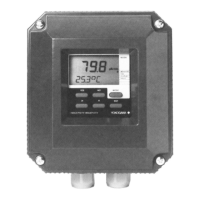IM 12D7B2-E-H
6-1. Introduction
The EXA SC200 microprocessor based
conductivity analyser continuously monitors
the condition of all key components of the
measuring system to ensure that measure-
ment is dependable. If a fault is detected
this is immediately signalled. Errors are
shown on the display with a code.
The following table shows the errors which
can be detected and gives information to
help locate the fault or identify the error.
Faults detected whilst the instrument is on
line can also be signalled by a (temporary)
high output signal (22 mA).
6-2. Self diagnostics of the conductivity
cell
During measurement the instrument adjusts
the measuring frequency to give the best
conditions for the actual value being meas-
ured. At low conductivity there is risk of
error due to capacitive effects in the cable
and cell. These are reduced by using a low
measuring frequency. At high conductivity
these capacitive effects become negliable
and errors are more likely to be caused by
polarisation or fouling of the cell. These
errors are reduced by increasing the measu-
ring frequency.
At all values the instrument checks the sig-
nal from the cell to search for distortion
which is typical of capacitive or polarisation
errors. If there is a problem with the installa-
tion or the cell becomes fouled this will trig-
ger an error message on the display possi-
bly accompanied by a fault signal through a
(temporary) high output current (22 mA).
6-3. Self diagnostics of the temperature
sensor
The temperature sensor, which is normally
built into the conductivity cell, is checked to
detect damage or faulty connections.
NOTE:
A temperature fault may be caused by
incorrect programming of the temperature
element!
6-4. Self diagnostics of the electronics
The microprocessor operation is checked
by a watchdog which initiates an electronic
reset if the normal function suffers severe
interference. During reset the instrument
checks the program and all stored data. If a
fault is then detected an alarm is given.
6-5. Checking during operation
Whenever the instrument is being program-
med or calibrated, data is checked and an
error is shown when appropriate.
Should this occur the new data is rejected
and the instrument continues to work with
the previous settings.
26
6. TROUBLE SHOOTING

